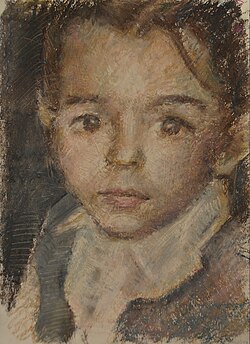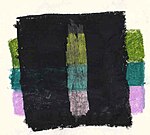Oil pastel
This article needs additional citations for verification. (June 2009) |

An oil pastel is a
History

At the end of
The new product was not completely satisfactory, as pigment concentration was low and blending was impossible, so in 1924 they decided to develop a high viscosity crayon: the oil pastel. This used a mixture of mashed
Oil pastels were an immediate commercial success and other manufacturers were quick to take up the idea, such as Dutch company Talens, who began to produce Panda Pastels in 1930. However, none of these were comparable to the professional quality oil pastels produced today. These early products were intended to introduce
In 1947, Picasso, who for many years had been unable to procure oil pastels because of the war conditions, convinced Henri Sennelier, a French manufacturer who specialized in high quality art products, to develop a fine arts version. In 1949, Sennelier produced the first oil pastels intended for professionals and experienced artists.[2] These were superior in wax viscosity, texture and pigment quality and capable of producing more consistent and attractive work. Picasso requested that these be produced in 48 different colours.[1]
The Japanese Holbein brand of oil pastels appeared in the mid-1980s with both student and professional grades; the latter with a range of 225 colours.
Use
Oil pastels can be used directly in dry form; when done lightly, the resulting effects are similar to oil paints. Heavy build-ups can create an almost impasto effect. Once applied to a surface, the oil pastel pigment can be manipulated with a brush moistened in white spirit, turpentine, linseed oil, or another type of vegetable oil or solvent. Alternatively, the drawing surface can be oiled before drawing or the pastel itself can be dipped in oil. Some of these solvents pose serious health concerns.[3]
Oil pastels are considered a fast medium because they are easy to paint with and convenient to carry; for this reason they are often used for sketching, but can also be used for sustained works. Because oil pastels never dry out completely, they need to be protected somehow, often by applying a special
Surface and techniques

The surface chosen for oil pastels can have a very dramatic effect on the final painting. Paper is a common surface, but this medium can be used on other surfaces including wood, metal, hardboard (often known as "masonite"), MDF, canvas and glass. Many companies make papers specifically for pastels that are suitable for use with oil pastels.
Building up layers of color with the oil pastel, called layering, is a very common technique. Other techniques include
Grades

There are a number of types of oil pastels, each of which can be classified as either scholastic, student or professional grade.
Scholastic grade is the lowest grade; generally the oil pastels are harder and less vibrant than higher grades. It is generally meant for children or new users of oil pastels, and is fairly inexpensive compared to other grades. The middle grade, student grade, is meant for art students and is softer and more vibrant than scholastic grade. They are usually more expensive. Professional grade is the highest grade of oil pastel, and are also the softest and most vibrant, but can be very expensive.
See also
References
- ^ ISBN 978-1-78126-704-2.
- ^ "Art and History Intersect at a Paris Shop". NPR. 2006-07-27. Retrieved 2018-06-17.
- ^ "Section 10: Painting and Drawing". Environmental Health & Safety | Baylor University. Retrieved 2018-09-08.
Further reading
- Leslie, Kenneth. Oil Pastel: Materials and Techniques for Today's Artist, Watson-Guptill Publications, 1990. ISBN 0-8230-3310-4.
- M.H.Ellis, "Oil Pastel", in Media and Techniques of Works of Art on Paper, New York University Conservation Center of the Institute of Fine Arts, New York, 1999.
- Elliot, John. Oil Pastel: for the Serious Beginner, Watson-Guptill Publications, 2002. ISBN 0-8230-3311-2.
External links
- The Oil Pastel Society
- https://web.archive.org/web/20070716232500/http://palimpsest.stanford.edu/waac/wn/wn21/wn21-1/wn21-106.html for a discussion of the evaporation and efflorescence.
